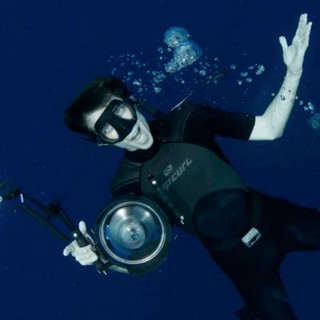Schmidt Ocean Institute’s research vessel Falkor recently arrived in Honolulu after a 21 day expedition across the equator looking at small-scale mixing in the central Pacific Ocean.
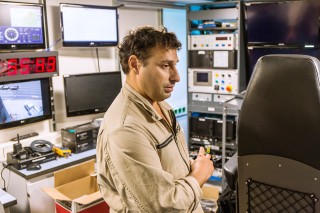
She is now undergoing scheduled upgrades before heading off in early October to map the world’s largest underwater volcano, Tamu Massif. While some of the projects during the upgrade are based on keeping the ship in excellent shape, others are working on expanding Falkor’s capabilities. The Audio Visual (AV) and Information Technology (IT) project that is currently being worked on, will not only bring new communication capabilities to scientists on Falkor, but improve the speed and way they communicate with those back on land.
Video Conferencing and Library Upgrades
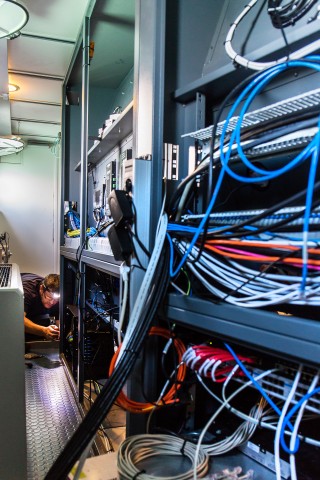
A prime gathering place onboard, the library is more than just a room for books. Modifications to the library will include new video conferencing capabilities allowing for participation in shore-based meetings and live ship-to-shore connections. On every cruise, the multimedia journalist and scientists on board will connect with aquariums, museums, and classrooms to share about the science they are conducting and life at sea. To ensure quality audio during these connections, the new upgrades will also include voice activated microphones that can filter out ambient ship noise for clearer connections.
Video Cameras and Screens
Two cameras will also be installed in the library, so presentations or ship-to-shore connections can be streamed live to YouTube. In addition to the cameras, four other video cameras will be installed in locations on Falkor where science takes place. The new camera systems are a big part of bringing the science of Falkor to the public. This will increase Schmidt Ocean Institute’s ability to stream live footage of the research being conducted in real time to our live status page (https://schmidtocean.org/status/index.html). One camera will be focused on the launching bay so audiences can watch Remotely Operated Vehicle (ROV) and Autonomous Underwater Vehicle (AUV) deployments. There will also be two cameras facing the aft deck, and one on the ship’s A-frame crane – all great viewpoints to observe launch and recoveries of shipboard instruments.
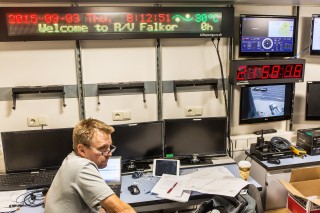
In addition to the cameras, the library will be outfitted with four additional screens so that it can be used as an extended science control room and live presentation center. Scientists and crew in the library will now have access to all systems with new screens and touch-pad controls. This will now make two rooms available for managing science systems simultaneously (e.g.) controlling a ROV and mapping.
Both the cameras and screens will improve video conferencing used by scientists and the communication teams for outreach and community engagement. The ship’s crew can also use this system to enhance collaborations with shoreside operations.
The Science Hub: Control Room
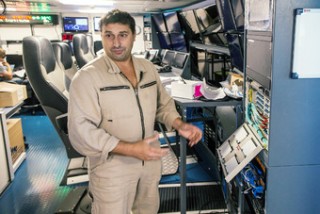 The control room is ground zero for the technological enhancements. When improvements are completed, the video matrix system will have doubled its port input from 32 to 64, getting ready for the new Remotely Operated Vehicle which will be built in 2016. In total, there will be eight cameras for the ROV vehicle and 11 cameras in total for the digital video camera network. The intended usage for the new system will be science operations and live streaming, allowing participants to observe and take part in the science from anywhere, including shore. Also added to the control room is a new mapping console, which includes a post-processing corner that expands both space and utility.
The control room is ground zero for the technological enhancements. When improvements are completed, the video matrix system will have doubled its port input from 32 to 64, getting ready for the new Remotely Operated Vehicle which will be built in 2016. In total, there will be eight cameras for the ROV vehicle and 11 cameras in total for the digital video camera network. The intended usage for the new system will be science operations and live streaming, allowing participants to observe and take part in the science from anywhere, including shore. Also added to the control room is a new mapping console, which includes a post-processing corner that expands both space and utility.
The crew of Falkor has been busy with other science systems as well. A new cable for the CTD control has been installed to ensure the cleanest CTD data available. The team has also added new science sensors, which means added variety in ocean observing data for future studies.
Information Technologies
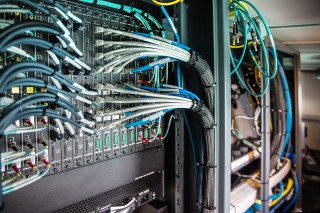 Last but certainly not least, the team has been working hard on Falkor’s information technology improvements including upgrades to the ship’s server, installing a new backup server with additional storage, and harmonizing antivirus software. In the science rack room, modifications are being made where the high performance supercomputer will be supported, and installation of a bandwidth management system is currently being completed that will allow for maximum internet use by everyone on board.
Last but certainly not least, the team has been working hard on Falkor’s information technology improvements including upgrades to the ship’s server, installing a new backup server with additional storage, and harmonizing antivirus software. In the science rack room, modifications are being made where the high performance supercomputer will be supported, and installation of a bandwidth management system is currently being completed that will allow for maximum internet use by everyone on board.
A ship is meant to be at sea, so every minute Falkor is docked must be treated as an investment. Time ashore is an important foundation for success on the water. The more capable and efficient Falkor is for future expeditions, the more discoveries and understanding scientists and the public stand to gain.
